تناقش هذه المقالة أفضل ست ممارسات للتنبؤ بالطلب في مجال الخدمات اللوجستية. اتصل بنا اليوم لمعرفة كيف يمكننا مساعدتك في التنبؤ بالطلب بدقة!
هل استمعت إلى توقعات الطقس في دبي اليوم؟ كيف كانت؟
"يمكنك أن تتوقع طقسًا دافئًا مع الكثير من أشعة الشمس طوال الصباح."
"قد تظهر السحب الحملية من الشرق بعد الظهر."
"قد يصبح الطقس عاصفًا وضبابيًا في الليل."
ويبدو أن توقعات الطلب على الخدمات اللوجستية مشابهة.
"نتوقع يومًا مزدحمًا بالعديد من طلبات التوصيل في منطقة خدمة معينة."
"من المرجح أن يصل الطلب إلى ذروته عند منتصف النهار."
"في أعقاب المناسبات الاحتفالية القادمة، قد نتلقى الكثير من الشحنات من شركات الشحن في الأشهر المقبلة."
لنكن صادقين: كل صاحب عمل يتمنى أن يكون قادرًا على رؤية المستقبل. إنها رغبته العميقة!
ورغم أن هذا ليس ممكنا بشريا، فمن حسن الحظ أننا نمتلك أقرب شيء إلى الكرة البلورية المثالية ــ التنبؤ بالطلب.
إنها عملية يمكن من خلالها للشركات التنبؤ بالطلب المستقبلي على المنتجات والتخزين والنقل والخدمات في سلسلة التوريد. وتتطلب تحليلاً شاملاً لسجلات الطلبات السابقة وبيانات التسليم وأنماط التسعير وتفاعلات العملاء خلال فترات مختلفة، مع الأخذ في الاعتبار اتجاهات السوق الحالية والمتغيرات الزمنية الأخرى لإعلام التوقعات المتعلقة بالنمو أو الانحدار في الطلب.
كيف تستفيد أعمالك اللوجستية من التنبؤ بالطلب
إن التنبؤات الدقيقة بالطلب المستقبلي مفيدة لشركات الخدمات اللوجستية بعدة طرق. فهي تسمح لها بالاستجابة بشكل أسرع لتحولات السوق، وتوفير تكاليف سلسلة التوريد، وتلبية توقعات العملاء، وتأسيس قراراتها على بيانات ملموسة بدلاً من التلميحات والتخمينات. وعندما يتم ذلك بشكل صحيح، يمكن أن يكون التنبؤ بالطلب ميزة تنافسية كبيرة لمشغلي الخدمات اللوجستية.
تحسين إدارة المخزون
إن إحدى الطرق الأكثر وضوحًا التي يستفيد بها عملك من التنبؤ بالطلب هي من خلال إدارة المخزون بشكل أفضل. عندما تتمكن من التنبؤ بدقة بما سيشتريه العملاء، يمكنك الحفاظ على مستويات المخزون لديك متوازنة بما يكفي لتلبية الارتفاع المحتمل في الطلب دون طلب الكثير أو مخزون قليل جدًا.
مزيد من توفير التكاليف
إن توفير التكاليف هو فائدة مباشرة للتنبؤ الفعال بالطلب. فعندما تفرط في تخزين السلع، فإنك تحجز قدرًا كبيرًا من رأس المال في المخزون. ومن ناحية أخرى، عندما لا تفعل ذلك، فإنك توفر الكثير من رسوم التخزين والمستودعات، كما تقل مخاطر أن تصبح السلع غير المباعة قديمة. بالإضافة إلى ذلك، مع وجود رأس مال إضافي في متناول اليد، يمكنك الإنفاق على أشياء أخرى. المجالات الرئيسية لنمو الأعمالإن إدارة التدفق النقدي بشكل أفضل وتقليل النفايات تؤدي بطبيعة الحال إلى تحقيق وفورات ضخمة بمرور الوقت.
المزيد من العملاء الراضين
لا شك أن تلبية الشركات لتوقعات العملاء دون تأخير يحسّن من رضا العملاء بشكل كبير. فالمستهلكون يريدون الحصول على مشترياتهم بسرعة ودون أي متاعب. وعندما تكون مستعدًا تمامًا لتلبية الطلب المتقلب، فإنك تتجنب الانتظار الطويل والطلبات المؤجلة، مما يضمن بقاء عملائك مخلصين وراضين.
دورات إنتاج فعالة
كما أن التنبؤ بالطلب في مجال الخدمات اللوجستية له تأثيرات إيجابية على دورة الإنتاج الإجمالية وسلسلة التوريد. ومع وجود رؤى أكثر دقة للطلب القادم، يمكن للمصنعين مواءمة جداول الإنتاج الخاصة بهم لتجنب التوقف غير الضروري. كما تصبح سلاسل التوريد أكثر كفاءة عندما تعرف مسبقًا أين ومتى ستكون هناك حاجة إلى مواد خام أو منتجات نهائية معينة وتتخذ الترتيبات اللازمة لتسريع الخدمات اللوجستية.
خطط المبيعات والتسويق المستهدفة
تستفيد الحملات التسويقية والمبيعات بشكل كبير من التنبؤ بالطلب في مجال الخدمات اللوجستية أيضًا. من خلال فهم واضح للطلب المستقبلي، يمكنك التخطيط للحملات الترويجية أو إطلاق المنتجات في الأوقات الأكثر ملاءمة. استهداف أنشطتك التسويقية بناءً على أهم الاتجاهات الناشئة في تفضيلات العملاء يساعدك على تحسين ميزانية الإعلان الخاصة بك ويزيد العائد الإجمالي على الاستثمار في الحملات.
انخفاض المخاطر
وهذه فائدة أقل وضوحًا ولكنها مهمة على الرغم من ذلك للتنبؤ بالطلب. فالبيانات التنبؤية تسمح لك بتوقع التغيرات في السوق، والتكيف مع التقلبات الموسمية، والاستعداد للتحولات الاقتصادية مسبقًا. والقدرة على التكيف مسبقًا تعني تعرضًا أقل للاضطرابات غير المتوقعة في السوق.
الاستشراف للتخطيط للمستقبل
إن استراتيجية الأعمال طويلة الأجل هي مجال آخر يثبت فيه التنبؤ بالطلب أهميته البالغة. فمن خلال الحصول على صورة أوضح لتفضيلات العملاء في المستقبل واتجاهات السوق، يمكن للشركات اتخاذ قرارات مستنيرة فيما يتعلق بتطوير المنتجات والتوسع المحتمل في السوق. وبدلاً من إضاعة الوقت في التخمينات، فإن التنبؤ بالطلب في مجال الخدمات اللوجستية يرشد التحركات التجارية الاستراتيجية التي يمكن دعمها برؤى قائمة على البيانات.
التخصيص الأمثل للموارد
أخيرًا، إذا تمكنت من تحديد الوظيفة أو الخدمة التي من المتوقع أن يكون هناك طلب مفرط عليها قريبًا، فيمكنك تعيين الموظفين والمعدات والموارد الأخرى للحفاظ على معايير خدمة العملاء عالية الجودة وتجنب التكاليف غير الضرورية للطلبات المؤجلة ونفاد المخزون.
6 أفضل الممارسات للتنبؤ بالطلب في مجال الخدمات اللوجستية
إن أهمية التنبؤ بالطلب في مجال الخدمات اللوجستية لا يمكن إنكارها (كما أسسنا للتو)، ولكن تظل الحقيقة أنك بحاجة إلى نهج متكامل للتخطيط والتنبؤ بالطلب المستقبلي من أجل الاستمرار في تقديم قيمة أكبر لعملائك.
فيما يلي ستة أفضل الممارسات التي ستساعدك على توقع متطلبات السوق وتحسين عملياتك بشكل أفضل.
1. جمع البيانات الصحيحة واستخدامها
البيانات هي الأساس لأي استراتيجية ناجحة للتنبؤ بالطلب. ابدأ بجمع النوع الصحيح من البيانات. بدلاً من جمع كل قطعة من البيانات المتاحة، ركز على المقاييس عالية الجودة والعميقة التي لها تأثير مباشر على نتائج عملك. في صناعة التخزين والخدمات اللوجستية، على سبيل المثال، من المهم جمع البيانات حول:
- مستويات المخزون
- وقت دورة الطلب
- معدل الطلبات المؤجلة
- معدل إرجاع المنتج
- أحجام الشحن
- الوقت من الرصيف إلى المخزون
- قيمة عمر العميل
- معدل فقدان العملاء
2. مراعاة المتغيرات الخارجية
لا تتم عملية التنبؤ بالطلب بمعزل عن العوامل الأخرى. فهناك العديد من العوامل الخارجية التي قد تؤثر على الطلب، ومن الأهمية بمكان ضبط هذه المتغيرات لتجنب الأخطاء. وقد تشمل هذه المتغيرات الاتجاهات الموسمية، وتحولات السوق، والظروف الاقتصادية، وحتى الأحداث غير المتوقعة مثل الكوارث الطبيعية أو اضطرابات سلسلة التوريد العالمية.
على سبيل المثال، يجب على شركة الخدمات اللوجستية تعديل توقعاتها لتشمل العطلات، أو التغيرات الموسمية في سلوك المستهلك، أو ارتفاع الطلب في السوق على منتجات معينة. وعلى نحو مماثل، عندما يكون الطلب على منتج موسميًا أو قائمًا على اتجاهات ناشئة، يجب عليك دمج هذه العوامل في نماذج التنبؤ لضمان تنبؤات أكثر دقة. سيساعدك تحديد هذه المتغيرات وتعديلها على البقاء نشطًا ومستعدًا في جميع الأوقات!
3. استخدم الرؤية في الوقت الفعلي لتحسين الدقة
إن الرؤية المباشرة لأنشطة سلسلة التوريد ضرورية لإجراء توقعات دقيقة للطلب. ويتضمن ذلك الحصول على رؤية واضحة ودقيقة لمستويات المخزون وحالات الطلبات وجداول النقل والعوامل التشغيلية الأخرى. يمكن للبيانات المباشرة أن تساعد شركات الخدمات اللوجستية مثل شركتك على الاستجابة بسرعة لظروف السوق المتغيرة وتقلبات الطلب.
عندما يكون لديك إمكانية الوصول إلى أدوات الرؤية في الوقت الفعلي، يمكنك مراقبة سلاسل التوريد الخاصة بك باستمرار، واكتشاف التحولات في الطلب، واتخاذ التدابير بشكل استباقي. يمكن أن تتضمن هذه التدابير تعديلات استباقية لمستويات المخزون وجداول الإنتاج وخطط التوزيع. يمكن أن تساعدك الرؤى في الوقت الفعلي أيضًا في تحسين مساراتك، والتخطيط للرحلات متعددة المحطات، وإعطاء الأولوية للتسليمات.
4. استخدم الذكاء الاصطناعي للتنبؤ بالطلب
نحن نعيش في العصر الرقمي اليوم، لذا يجب أن يكون هذا أمرًا بديهيًا. بالتأكيد، كان التنبؤ في Excel هو القاعدة خلال العقود القليلة الماضية. ومع ذلك، تتطلب الأوقات الحديثة حلولاً حديثة. يعد Excel نقطة بداية جيدة للشركات الجديدة، لكنه لا يزال يدويًا وبطيئًا وغير قابل للتطوير، مقارنة بأدوات التنبؤ الحالية. حلول إدارة التسليم الآلية مدعومة بالذكاء الاصطناعي (AI) والتعلم الآلي (ML).
تستخدم هذه البرامج خوارزميات الذكاء الاصطناعي والتعلم الآلي المتقدمة لمعالجة كميات هائلة من تحليلات البيانات التاريخية وظروف المناطق والطرق في الوقت الفعلي وتحديد الأنماط والاتجاهات المتغيرة في غضون ثوانٍ. كما أنها تقدم تنبؤات بدقة أكبر من أنظمة التنبؤ القديمة مثل Excel وGoogle Spreadsheet.
5. مراقبة وتعديل التوقعات بشكل منتظم
لا يسعنا إلا أن نؤكد على أهمية هذا الأمر: إن التنبؤ بالطلب ليس عملية تتم لمرة واحدة. بل يتطلب الأمر مراقبة مستمرة وتعديلات لتظل فعّالة لفترة طويلة من الزمن. ولابد من مقارنة التوقعات بانتظام بالطلب الفعلي لتحديد أي تناقضات أو مجالات تحتاج إلى تحسين. ومن خلال مراجعة دقة وأداء التوقعات بشكل مستمر، تستطيع شركات الخدمات اللوجستية ضبط نماذج التنبؤ لديها والتكيف مع التغيرات في ظروف السوق أو سلوك المستهلك أو التأثيرات الخارجية.
على سبيل المثال، إذا كانت أرقام المبيعات الفعلية تختلف بشكل كبير عن الطلب المتوقع، فمن الضروري التحقيق في السبب وتحديث نموذج التنبؤ وفقًا لذلك. يضمن هذا النهج التكراري أن يصبح التنبؤ بالطلب أكثر دقة بمرور الوقت.
6. مواءمة التوقعات مع الأهداف الاستراتيجية
أخيرًا، يجب أن يتوافق التنبؤ بالطلب دائمًا مع الأهداف الاستراتيجية الأوسع لشركتك. الغرض من التنبؤ ليس فقط التنبؤ بالمبيعات أو الطلب على المنتج - بل هو إبلاغ القرارات الاستراتيجية التي تدفع العمل إلى الأمام. بصفتك مالكًا لشركة لوجستية، يجب عليك تحديد أهداف واضحة لمنتجات التنبؤ بالطلب، سواء كان ذلك تقليل تكاليف الاحتفاظ بالمخزون أو تحسين جداول التسليم أو زيادة رضا العملاء.
كما ينبغي دمج توقعات الطلب في جهود التخطيط الاستراتيجي الأوسع نطاقاً، مثل تحسين المسارات وإدارة المستودعات وتخصيص الموارد، في ما يتصل بعمليات الخدمات اللوجستية. على سبيل المثال، إذا كنت تتوقع زيادة في الطلب خلال موسم الذروة، فقد تفكر في توظيف المزيد من الموظفين، أو توسيع سعة المستودعات، أو حتى الشراكة مع شركات نقل إضافية لتلبية الطلب المتزايد بكفاءة.
نصيحة إضافية:
كن شريكًا مع Mile للحصول على توقعات دقيقة للطلب
يجمع برنامج إدارة التسليم الخاص بـ Mile النوع الصحيح من البيانات، ويأخذ في الاعتبار المتغيرات الخارجية، ويوفر رؤية في الوقت الفعلي، ويستفيد من خوارزميات الذكاء الاصطناعي والتعلم الآلي المتقدمة، ويتكيف مع نماذج التنبؤ مع الظروف المتغيرة، ويوازنها مع أهداف شركتك قصيرة المدى وطويلة المدى.
جدولة عرض توضيحي اليوم لتعلم كيف يمكن لحلنا أن يساعدك في التنبؤ بدقة بالنمو المستقبلي أو التقلبات في الطلب.

